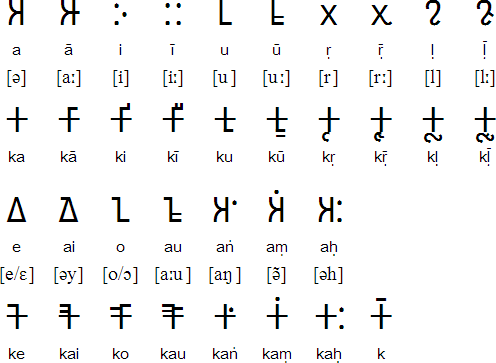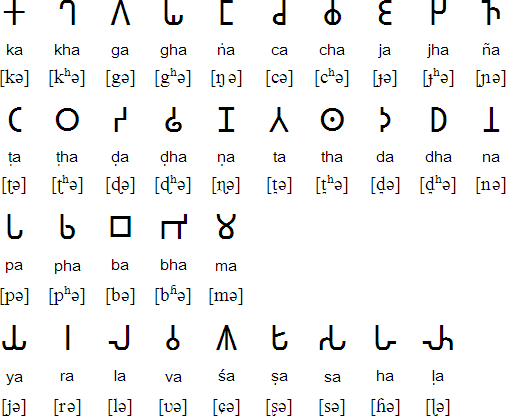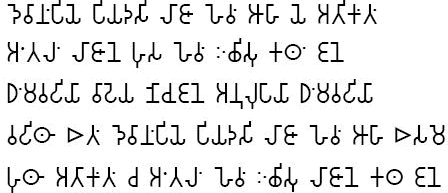Notable features
- Type of writing system: abugida - each letter represents a consonant with an
inherent vowel. Other vowels were indicated using a variety of diacritics
and separate letters.
- Letters are grouped according to the way they are pronounced.
- Many letters have more than one form.
- Direction of writing: left to right in horizontal lines
Vowels and vowel diacritics

Consonants

Sample text

Asokan Edict - Delhi Inscription
Transliteration
devānaṁpiye piyadasi lājā hevaṁ āhā ye atikaṁtaṁ
aṁtalaṁ lājāne husa hevaṁ ichisu kathaṁ jane
dhaṁmavaḍhiyā vāḍheya nocujane anulupāyā dhaṁmavaḍhiyā
vaḍhithā etaṁ devānaṁpiye piyadasi lājā hevaṁ āhā esame
huthā atākaṁtaṁ ca aṁtalaṁ hevaṁ ichisu lājāne katha jane
Translation
Thus spoke king Devanampiya Piyadasi: “Kings of the olden time have gone to heaven under
these very desires. How then among mankind may religion (or growth in grace) be increased?
Yea, through the conversion of the humbly-born shall religion increase”
Source: http://www.virtualvinodh.com/brahmi-lipitva/144-asokan-edict-delhi
Some modern descendants of Brāhmī
Bengali,
Devanāgarī,
Gujarāti,
Gurmukhi,
Kannada,
Khmer,
Malayalam,
Odia,
Sinhala,
Tamil,
Telugu,
Tibetan
Links
Information about Brāhmī
http://en.wikipedia.org/wiki/Br%C4%81hm%C4%AB_script
http://www.virtualvinodh.com/brahmi-lipitva
http://www.ancientscripts.com/brahmi.html
http://www.nibbanam.com/Brahmi/brahmi.htm
Brāhmī fonts
https://sites.google.com/site/brahmiscript/
The Edicts of King Asoka
http://www.cs.colostate.edu/~malaiya/ashoka.html
ALPHABETUM - a Unicode font
specifically designed for ancient scripts, including classical
& medieval Latin, ancient Greek, Etruscan, Oscan, Umbrian,
Faliscan, Messapic, Picene, Iberian, Celtiberian, Gothic, Runic,
Old & Middle English, Hebrew, Sanskrit, Old Nordic, Ogham,
Kharosthi, Glagolitic, Old Cyrillic, Phoenician, Avestan, Ugaritic,
Linear B, Anatolian scripts, Coptic, Cypriot, Brahmi, Old Persian cuneiform:
http://guindo.pntic.mec.es/~jmag0042/alphabet.html
Some of the writing systems used to write Sanskrit
- Ahom,
- Badaga,
- Balinese,
- Batak,
- Baybayin (Tagalog),
- Bengali,
- Bima,
- Blackfoot,
- Brahmi,
- Buhid,
- Burmese,
- Carrier,
- Chakma,
- Cham,
- Cree,
- Dehong Dai,
- Devanagari,
- Dives Akuru,
- Ethiopic,
- Evēla Akuru,
- Fraser,
- Gondi,
- Grantha,
- Gujarati,
- Gupta,
- Gurmukhi,
- Hanuno’o,
- Inuktitut,
- Javanese,
- Jenticha,
- Kaithi,
- Kannada,
- Kawi,
- Kharosthi,
- Khmer,
- Khojki,
- Kulitan,
- Lampung,
- Lanna,
- Lao,
- Lepcha,
- Limbu,
- Lontara/Makasar,
- Malayalam,
- Manpuri,
- Modi,
- Mongolian Horizontal Square Script,
- Mro,
- New Tai Lue,
- Ojibwe,
- Odia,
- Pahawh Hmong,
- Pallava,
- Phags-pa,
- Ranjana,
- Redjang,
- Sasak,
- Satera Jontal,
- Shan,
- Sharda,
- Siddham,
- Sindhi,
- Sinhala,
- Sorang Sompeng,
- Sourashtra,
- Soyombo,
- Sundanese,
- Syloti Nagri,
- Tagbanwa,
- Takri,
- Tamil,
- Telugu,
- Thai,
- Tibetan,
- Tigalari (Tulu),
- Tikamuli,
- Tocharian,
- Tolong Siki,
- Varang Kshiti
http://www.indicstudies.us/Archives/Linguistics/Brahmi.html
The Brahmi script was the
ancestor of all
South Asian writing
systems. In
addition, many East and Southeast Asian scripts,
such as Burmese, Thai,
Tibetan, and even
Japanese to a very small extent (vowel order),
were also ultimately derived from the Brahmi
script. Thus the Brahmi script was the Indian
equivalent of the Greek script that gave arise
to a host of different systems. You can take a
look at
the evolution of Indian scripts,
or
the evolution of Southeast Asian scripts.
Both of these pages are located at the very
impressive site
Languages and Scripts of India.
You can also take a look at
Asoka’s edict at Girnar,
inscribed in the Brahmi script.
Related links:
























